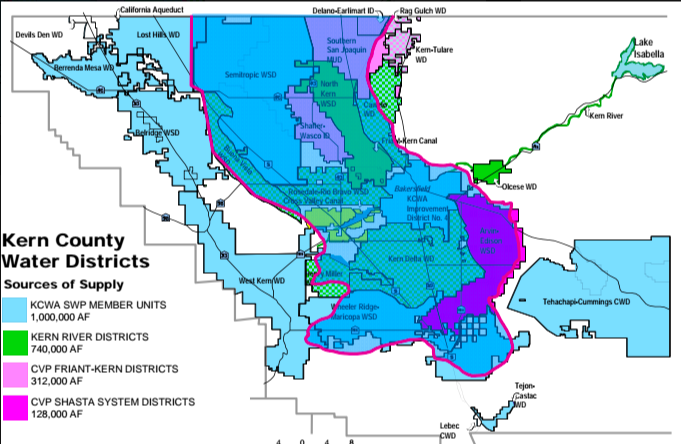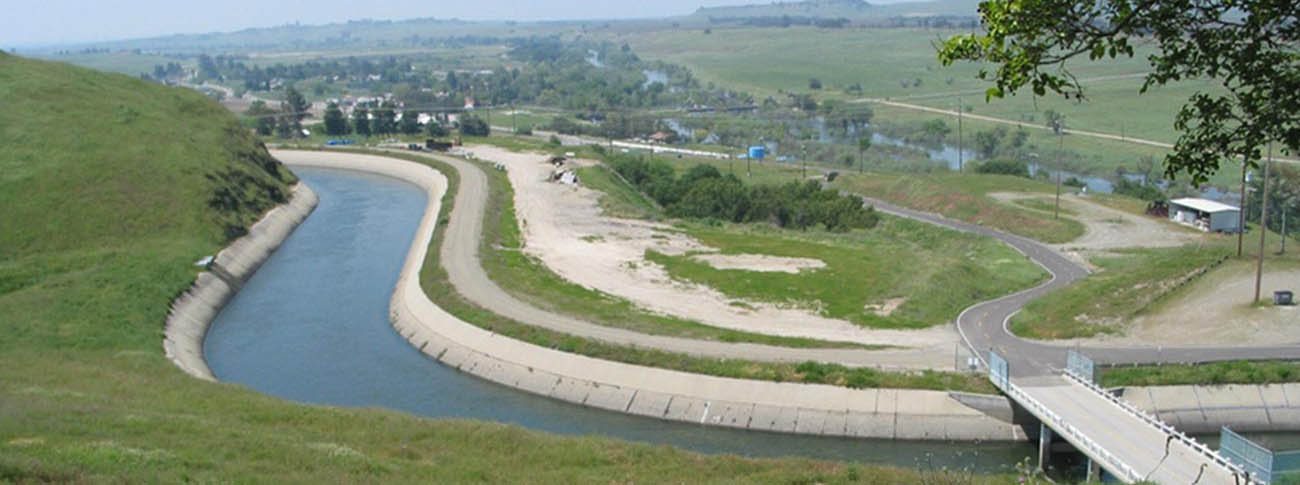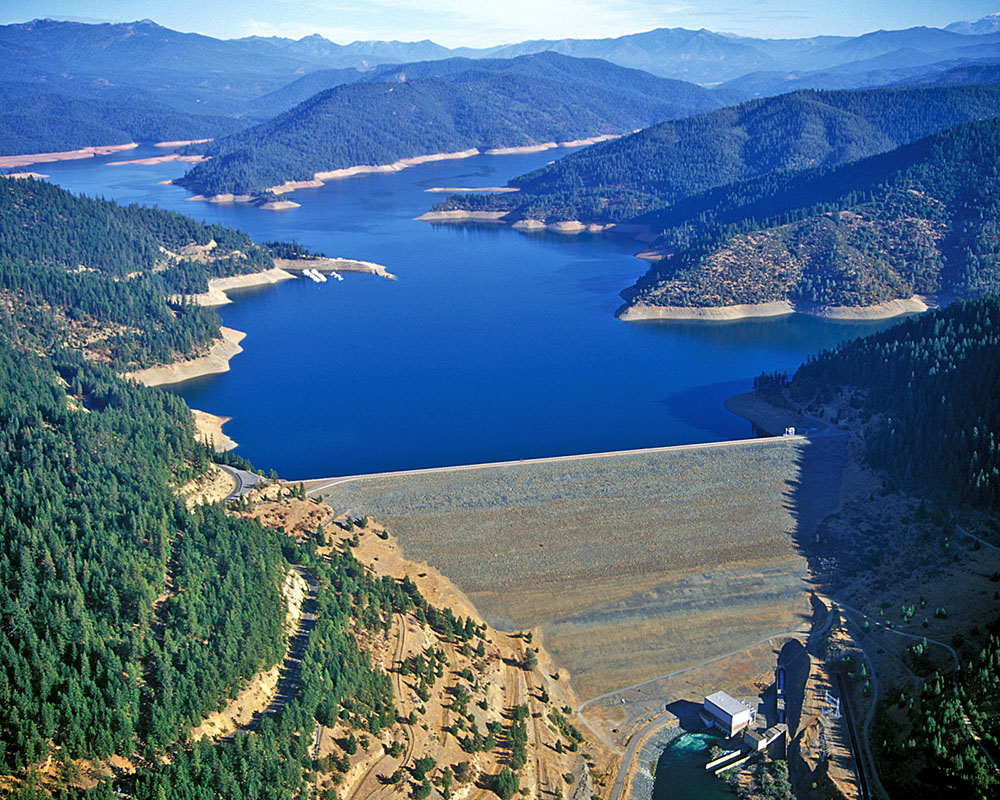
Kern County Water Districts. (Photo: Kern County Water Agency)
Kern County Water Districts and White Lands – Kern County Water Agency
Enviros reinvent wheel of groundwater markets; circular ‘white land’ buy outs in Kern County
By Wayne Lusvardi, February 27, 2020 11:22 am
A controversial aspect of new California groundwater regulation is the unofficial collaboration of the Environmental Defense Fund to structure water markets that previously failed; and circular buy-outs of farmlands funded with high water rates paid by the same farmers whose lands are to be bought out.
Water districts in Kern County are being placed in the unwanted role of having to now enforce the California Sustainable Groundwater Management Act of 2014 (SGMA – AB 1739, Dickinson-D; SB 1319 and SB 1168, Pavley-D). The only regulatory powers granted to water districts under the SGMA is fines for pumping more water than allocated.
Under the new law, agricultural users of groundwater must either be in a water district or they will have to join a new State Groundwater Management Agency (SGMA) if they want to continue to pump groundwater from “overdrafted” water basins. But as will be discussed below this is nearly impossible in the Tulare Basin in Kern County.
To make enforcement of the law even more problematic, the Environmental Defense Fund (EDF) is collaborating with water districts to structure water markets and buy-outs of “white lands” outside water districts. “White lands” are lands outside water districts that solely rely on pumping groundwater rather than having a district buy imported water from the state or federal water projects. They are called “white lands” because they are colored white on water basin maps.
New Water Rates for “White Lands”
The new water rate for “white lands” owners from the Buena Vista Water Storage District in Kern County is a shocking $770 per acre-foot compared to $17/acre-foot in the Kern-Delta Water District and $61.77/acre-foot for State Water Project water for Eastside Kern users (see here: page 2-13). It must be understood that $770 per acre-foot is the price in an expected dry year and that a wet-year price might be half that price. The new, high water rate does not apply to small farmers or for domestic users who own 10 acres of land or less (an acre-foot of water an acre of land one foot high in water; typically enough for one-third land acre of row crops or almonds).
Enviro’s Computerized Water Market Already Tried and Failed
The Environmental Defense Fund (EDF) is now collaborating with water districts in Kern County to structure a water market. The EDF has engaged West Water Research consulting firm to help water districts structure a computerized water market in Kern County. However, the EDF doesn’t particularly have a good track record with local farmers after it opposed Westland’s Water District’s drainage into the Kesterson National Wildlife Refuge in 1983 (see page 204-205, here).
A computerized, voluntary water market was previously operated by the giant Westland’s Water District but was shut down in 2007 due to lack of trades during droughts when there is little excess water to trade. It has been pointed out that only a true “spec water commodities market” would work in California instead of merely a computer trading platform that has no banked water to trade. A water market is predicated on having firm water rights, which “white lands” farmers do not have other than water that runs with the land or river. Other water users depend on state and federal water allocations that unpredictably bounce from 5 percent to 100 percent each year depending on the wet/dry water cycle.
Moreover, Kern County farmer and water entrepreneur John Vidovich is working on an ambitious project of capturing excess flood waters off the Kings River in Kings County in “cell” reservoirs and sending it south through the state aqueduct to Kern County. Vidovich is also president of the Buena Vista Water Storage District’s offering the $770/acre foot water mentioned above. When $770/AF water is blended with nominal cost groundwater the actual cost comes down. But the high priced water is a risky gamble because a farmer may buy the water only to find he doesn’t need it and buying it year-over-year would be “unsustainable”.
Circular-Funded Land Retirement Program
Another controversial program is land retirements. Water districts are offering a voluntary land buy-out program but funded by an even higher water surcharge on water purchases. So the farmers would end up paying for their own land buyouts or they face devaluation of their lands from productive cropland ($8,000 to $20,000 per acre) to grazing land ($450 to $1,250 per acre) or open lands (less than $450/acre). It is estimated that 500,000 acres of land will be subject to retirements under the SGMA.
Is Balancing Tulare Water Basin a Crisis or Necessary?
Only the Tulare Water Basin in the California’s southern Central Valley, is in long term decline (see chart here), although there are several smaller basins also out of balance. Despite the so-called groundwater crisis from 2011 to 2015, a study conducted by the National Academy of Sciences concluded the Tulare Basin had 390-years of water storage remaining as of 2000. The U.S. Geological Survey concluded it would take 50 years for the Central Valley to naturally recharge the 100 million acre-feet of water depleted if all farm activities were halted instantly.
Long forgotten is that there once was a Tulare Lake that grew so large in wet years, it grew to over seven times the land area of Kern County, cutting the state in half. By diverting Tulare Lake’s flows to farmlands, modern agriculture made Kern County into the second most productive agricultural county in the U.S. But some politicians want to eradicate farming and bring back the old lake to supply large Southern California coastal cities.
- Peter Gleick’s National Water Plan for California - October 12, 2020
- Court Opens Up Big Prop.13 Loophole for ‘Public Franchise Fees’ - October 2, 2020
- New Cal Grid CEO is Ex-Enron Green Power Trader - September 29, 2020




